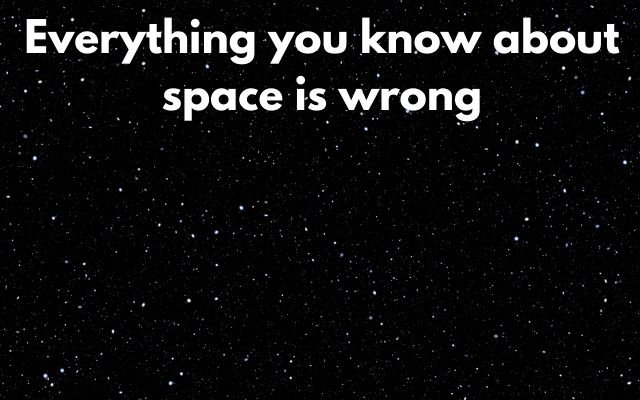Everything you know about space is wrong
Discover surprising truths about space and debunk common myths in "Everything You Know About Space is Wrong" by Matt Brown.

Do you think you know a lot about our solar system? You might want to reconsider. Many of the space “facts” you share with your friends could actually be incorrect. It’s surprising how much misinformation is out there about space. In fact, everything you know about space is wrong may not be far from truth!
Every time we go deeper into universe, we uncover fresh facts that contradict what we thought we knew. This implies that fresh research could refute previous conclusions. Because of this, next time you impart your solar system expertise, keep in mind that it’s wise to confirm your facts. You never know what fresh findings might throw light on alternative understanding of the cosmos!
In his new book, Everything You Know About Space Is Wrong, Matt Brown discusses the myths and misunderstandings about outer space and human exploration. Here are some space “facts” that you might have believed for a long time:
Table of Contents
Your Body Would Not Explode in the Vacuum of Space
What would happen if you floated out of an airlock without a spacesuit? Many people might think that you would explode or that your eyes would pop out, but that’s not entirely accurate. While the experience would be traumatic, you wouldn’t die instantly.
If your body were in vacuum of space, it would have to deal with several difficulties at once. The primary worry is that there wouldn’t be any oxygen, which would prevent breathing. In addition to the unusually low temperature, space radiation levels are also very high which is cause for alarm. None of these elements would, however, instantly kill you.
Furthermore, a drop in pressure would hasten the evaporation of bodily fluids like tears & saliva. Deeper liquids such as blood, would not boil, though. Your skin might bulge or inflate out as a result of the fluids expanding, but it wouldn’t be deadly. Your skin and connective tissues are strong enough to hold everything together, so while it would be an extremely uncomfortable situation, it is recoverable if you are rescued within about a minute.
Saturn Is Not the Only Ringed Planet
When we think of ringed planets, we usually think of Saturn. It’s famous for its beautiful rings, but it’s not the only planet with rings. In fact, about half of the planets in our Solar System have them! Jupiter, Uranus, and Neptune also have rings.
The Voyager probes, which explored the planets in the 1970s and 1980s, discovered these rings. Jupiter has four rings, Uranus has 13, and Neptune has five. While Saturn’s rings are the most visible and stunning, the gas giants all have rings, too.
Rings aren’t just for gas giants. In 2013, scientists found two rings around a small rock called 10199 Chariklo, located between Saturn and Uranus. This shows that even smaller objects can have rings.
Most ring systems have been found in our Solar System, but very few have been spotted outside of it. This might be because they’re rare or because they’re hard to see from far away. One interesting find was around a star named J1407, about 420 light years from Earth. This star has a giant ring system that is about 640 times wider than Saturn’s rings. It has been called “Saturn on steroids.”
While Saturn is well-known for its rings, it is not the only planet with this feature. Other planets in our Solar System, like Jupiter, Uranus, and Neptune, also have rings, showing that this can happen in many different types of celestial bodies.
Names in the Solar System
Many well-known objects in our Solar System are named after characters from mythology. For example, planets like Jupiter and Mars are named after Roman gods. Some of Uranus’s moons are named after characters from Shakespeare’s plays.
However, there are so many things in space to name that scientists have started using modern names too. Now, you can find names of people from today included in the list of Solar System objects.
For example, there’s a minor planet called 78453 Bullock, named after actress Sandra Bullock. You can also find 12818 Tomhanks for actor Tom Hanks and 8353 Megryan for actress Meg Ryan.
Even famous musicians and comedians have minor planets named after them. Each member of the Monty Python comedy group has a minor planet. The Beatles and Yoko Ono have minor planets too.
Some names are playful, like 4738 Jimihendrix for rock musician Jimi Hendrix and 14024 Procol Harum for the band that sang “A Whiter Shade of Pale.” There’s even 91287 Simon-Garfunkel, inspired by the song “The Sound of Silence.”
Then there’s 17473 Freddiemercury, named after the famous singer from Queen, known for his song “I Want to Break Free.” And 342843 Davidbowie reminds us of the song “Space Oddity.”
While many names in space come from ancient stories, modern culture has also added a lot of fun and familiar names, making the stars and planets feel more connected to our everyday lives.
The Truth About the Pole Star
The Pole Star, also known as Polaris, is located almost directly above the North Pole. This special position makes it very useful for navigation because if you find Polaris in the night sky, you can easily tell which way is north.
Many people believe that Polaris is the brightest star in the sky. While it is bright, it isn’t the brightest star; it ranks only among the top 50 brightest stars visible from Earth. In fact, Polaris is actually made up of three stars, but you can’t see this just by looking at it.
Additionally, the Pole Star’s position is not permanent. Over a long time, the Earth’s axis shifts, which changes the location of stars in the sky. So, while it’s a helpful guide now, it won’t always be.
In Shakespeare’s time, Julius Caesar referred to the northern star as being constant, but back then, there wasn’t a bright star directly above the North Pole like we have today.
No One Has Travelled Farther Than the Moon
So far, the farthest humans have traveled is to the Moon. The Apollo 13 astronauts hold the record for the greatest distance from Earth. After an explosion damaged their spacecraft, they flew around the back of the Moon, reaching a maximum distance of about 400,171 kilometers (around 248,700 miles) from Earth. No living person has been farther from home than they were.
However, if we consider a broader definition, there is one person who has traveled much farther. Clyde Tombaugh, who discovered Pluto in 1930, has a small sample of his ashes on NASA’s New Horizons spacecraft. This probe was launched in 2006 and flew past Pluto in 2015. As of February 2018, his ashes are over 40 astronomical units away from Earth (one astronomical unit is the average distance between the Earth and the Sun). While he may not be physically traveling, Tombaugh’s ashes are on their way to becoming the first human remains to reach interstellar space.
- Is the Dodo Really Extinct? A New Theory
- Can You Handle It? The World’s Hottest Places
- Gorillas’ Herbal Remedies: A Natural Cure for Human Diseases?
Everything You Know About Space is Wrong by Matt Brown, with illustrations by Sara Mulvanny, is available now for £9.99 from Batsford.



